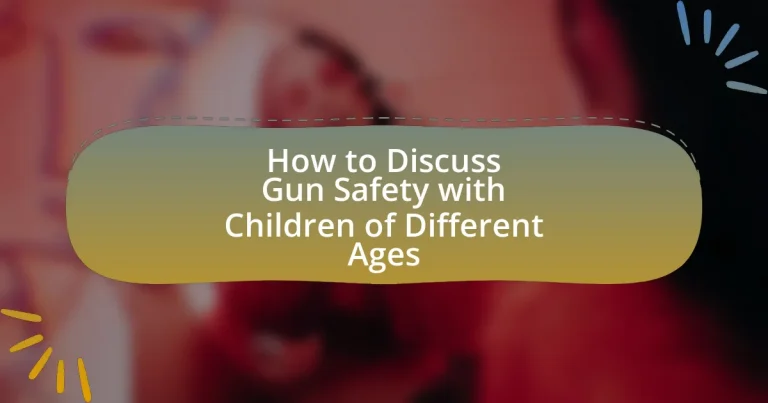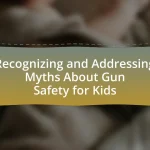The article focuses on the critical importance of discussing gun safety with children of various ages to prevent accidents and ensure their well-being. It highlights alarming statistics regarding unintentional firearm deaths among children and emphasizes the need for parents to engage in proactive conversations about recognizing firearms, understanding their dangers, and knowing appropriate responses. The article outlines age-appropriate strategies for discussing gun safety, including tailored approaches for preschoolers, school-aged children, and teenagers, while also addressing common misconceptions and the role of community resources in supporting these discussions. Key points include effective communication techniques, the significance of modeling behavior, and practical tips for fostering responsible attitudes towards firearms.
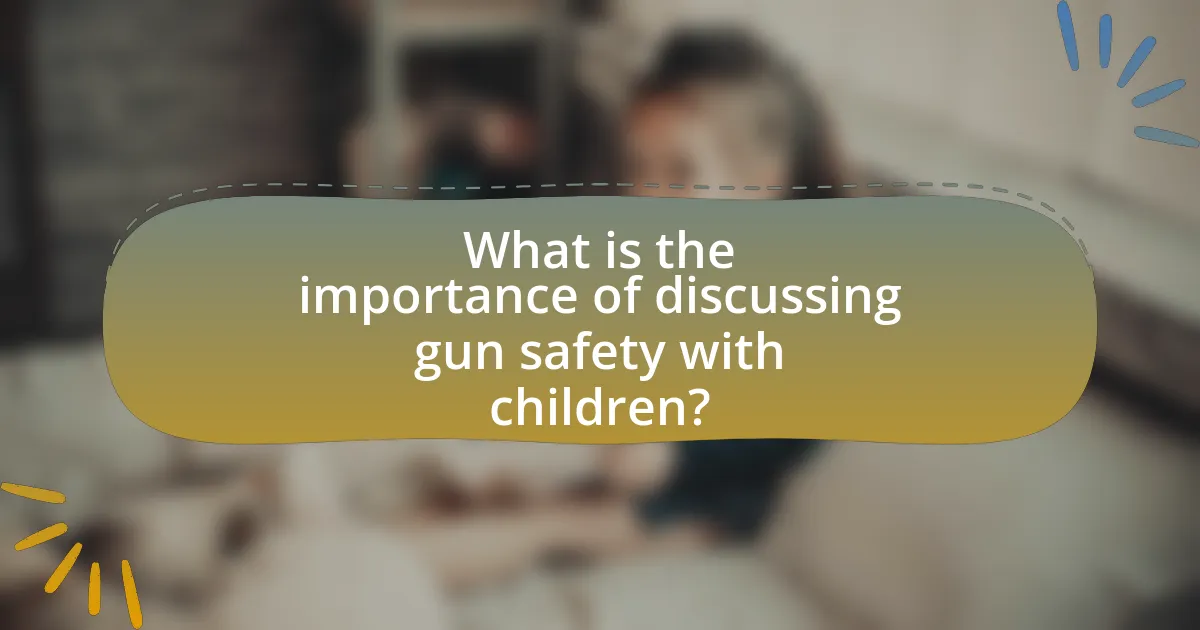
What is the importance of discussing gun safety with children?
Discussing gun safety with children is crucial for preventing accidents and ensuring their safety. Children are naturally curious, and without proper education about firearms, they may not understand the dangers associated with them. According to the Centers for Disease Control and Prevention (CDC), in 2020, there were over 4,300 unintentional firearm deaths among children in the United States, highlighting the urgent need for effective communication about gun safety. Teaching children about the importance of not touching guns, seeking adult help, and recognizing the potential dangers can significantly reduce the risk of firearm-related incidents.
Why should parents talk about gun safety with their children?
Parents should talk about gun safety with their children to prevent accidental injuries and fatalities. Statistics indicate that in the United States, nearly 400 children die each year from unintentional firearm injuries, highlighting the critical need for education on this topic. By discussing gun safety, parents can teach children how to recognize firearms, understand the dangers associated with them, and know the appropriate actions to take if they encounter a gun. This proactive approach significantly reduces the risk of tragic incidents and fosters responsible attitudes toward firearms.
What are the potential risks of not discussing gun safety?
The potential risks of not discussing gun safety include increased likelihood of accidental shootings, improper handling of firearms, and a lack of awareness about the dangers associated with guns. Research indicates that in homes without proper gun safety discussions, children are more likely to engage in risky behaviors, such as playing with firearms, leading to tragic outcomes. For instance, the American Academy of Pediatrics states that unintentional firearm injuries are a leading cause of death among children, emphasizing the critical need for open conversations about gun safety to mitigate these risks.
How can early discussions about gun safety impact children’s understanding?
Early discussions about gun safety significantly enhance children’s understanding of responsible behavior around firearms. Engaging children in conversations about gun safety from a young age helps them develop awareness of the potential dangers associated with guns, fostering a sense of responsibility and caution. Research indicates that children who receive early education on gun safety are more likely to recognize unsafe situations and respond appropriately, reducing the risk of accidental injuries. For instance, a study published in the journal “Pediatrics” found that children who participated in gun safety programs demonstrated improved knowledge and attitudes towards gun handling and safety practices. This proactive approach not only informs children but also empowers them to make safer choices in environments where firearms may be present.
What age-appropriate strategies can be used for discussing gun safety?
Age-appropriate strategies for discussing gun safety include using simple language for younger children, engaging in role-playing scenarios, and providing clear, factual information for older children. For instance, when talking to preschoolers, parents can explain that guns are not toys and should never be touched without an adult present. For school-aged children, discussions can involve identifying safe behaviors, such as telling an adult if they see a gun. Teenagers can handle more complex conversations about the responsibilities and consequences of gun ownership, emphasizing the importance of safety measures and legal implications. Research indicates that early and consistent conversations about gun safety can significantly reduce the risk of accidental shootings among children, highlighting the necessity of these strategies.
How does the approach differ for preschool-aged children?
The approach to discussing gun safety with preschool-aged children differs significantly from older age groups by emphasizing simple, clear language and concrete concepts. Preschoolers have limited cognitive abilities, so discussions should focus on basic safety rules, such as “Don’t touch” and “Tell an adult,” rather than complex explanations about firearms. Research indicates that children aged 3 to 5 learn best through play and repetition, making interactive methods, such as role-playing scenarios, effective for reinforcing these safety messages. Additionally, visual aids like pictures or toys can help convey the message in a way that is relatable and understandable for young children.
What key points should be covered with school-aged children?
Key points to cover with school-aged children regarding gun safety include understanding what guns are, recognizing the dangers associated with firearms, and knowing the importance of not touching a gun without adult supervision. Children should be taught to identify a gun and to alert an adult if they encounter one. Additionally, discussions should emphasize the concept of “stop, don’t touch, run away, and tell a grown-up” as a safety protocol. Research indicates that early education on gun safety can significantly reduce the risk of accidental shootings among children, highlighting the necessity of these discussions.
How can discussions evolve for teenagers?
Discussions can evolve for teenagers by incorporating their growing cognitive abilities and social awareness, allowing them to engage in more complex and nuanced conversations. As teenagers develop critical thinking skills, they can analyze different perspectives on gun safety, leading to deeper discussions that include ethical considerations, personal experiences, and societal impacts. Research indicates that adolescents are more receptive to discussions that involve their opinions and experiences, which can enhance their understanding and retention of information related to gun safety. For instance, a study published in the Journal of Adolescent Health found that peer-led discussions significantly improved teenagers’ knowledge and attitudes towards safety practices.
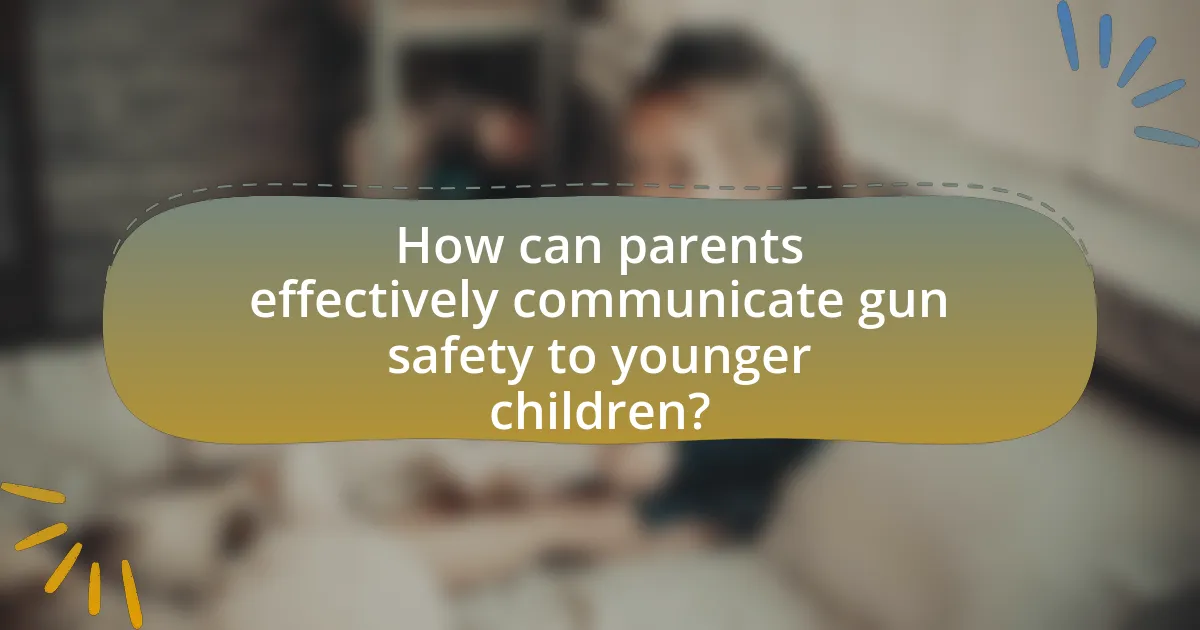
How can parents effectively communicate gun safety to younger children?
Parents can effectively communicate gun safety to younger children by using clear, age-appropriate language and engaging in open discussions about the topic. This involves explaining the concept of guns, emphasizing that they are not toys, and teaching children to recognize the importance of safety around firearms. Research indicates that children who receive consistent messages about gun safety from their parents are more likely to understand and remember these safety principles. For instance, the American Academy of Pediatrics recommends that parents use simple phrases like “Stop, don’t touch, run away, tell a grown-up” to help children respond appropriately if they encounter a gun.
What language and concepts are suitable for preschoolers?
Language and concepts suitable for preschoolers include simple, clear terms and basic safety concepts. Preschoolers benefit from using straightforward language that avoids complex vocabulary, focusing instead on words like “safe,” “danger,” and “stop.” Concepts should revolve around understanding personal safety, recognizing dangerous situations, and the importance of asking an adult for help. Research indicates that children aged 3 to 5 learn best through repetition and visual aids, making it effective to use pictures and role-playing scenarios to illustrate safety practices. This approach aligns with developmental psychology findings that emphasize the importance of concrete examples for young learners.
How can stories or games be used to teach gun safety?
Stories and games can effectively teach gun safety by engaging children in relatable scenarios that illustrate safe practices. For instance, interactive games can simulate situations where children must identify safe versus unsafe behaviors around firearms, reinforcing the importance of caution and awareness. Research indicates that children learn better through play and storytelling, as these methods enhance retention and understanding of complex concepts. A study published in the Journal of Adolescent Health found that educational games significantly improved knowledge retention regarding safety protocols among young participants. By incorporating narratives that emphasize the consequences of unsafe behavior, stories can also instill a sense of responsibility and encourage discussions about gun safety in a non-threatening manner.
What role does modeling behavior play in teaching young children?
Modeling behavior plays a crucial role in teaching young children by providing them with observable examples of appropriate actions and responses. When adults demonstrate safe practices, such as handling objects carefully or discussing safety protocols, children are more likely to imitate these behaviors, reinforcing their understanding of safety concepts. Research indicates that children learn effectively through imitation, as evidenced by studies showing that children who observe adults practicing safety behaviors are more likely to adopt those behaviors themselves. This observational learning is fundamental in contexts like gun safety, where modeling responsible behavior can significantly influence a child’s perception and actions regarding firearms.
How can parents ensure that school-aged children understand gun safety?
Parents can ensure that school-aged children understand gun safety by actively engaging them in age-appropriate discussions about firearms. This includes explaining the dangers of guns, teaching them to recognize a gun, and emphasizing the importance of not touching it without adult supervision. Research indicates that children who receive clear, direct information about gun safety are more likely to understand and remember safety protocols. For instance, a study published in the journal “Pediatrics” found that children who participated in structured gun safety education demonstrated improved knowledge and attitudes towards gun safety compared to those who did not receive such education.
What specific scenarios should be discussed with this age group?
Specific scenarios that should be discussed with children regarding gun safety include encountering a firearm in a public place, finding a gun at home, and being approached by someone who offers them a gun. These scenarios are critical as they help children understand the importance of not touching firearms and seeking help from an adult. Research indicates that children who are educated about these scenarios are less likely to engage in risky behavior when they encounter firearms, as highlighted in studies by the National Shooting Sports Foundation, which emphasize the effectiveness of scenario-based discussions in promoting safety awareness among children.
How can parents encourage questions and open dialogue about gun safety?
Parents can encourage questions and open dialogue about gun safety by creating a safe and non-judgmental environment for discussions. This involves actively inviting children to share their thoughts and concerns about guns, ensuring they feel comfortable asking questions without fear of reprimand. Research indicates that children are more likely to engage in conversations about sensitive topics when they perceive their parents as approachable and supportive. For instance, a study published in the Journal of Adolescent Health found that open communication between parents and children significantly enhances children’s understanding of safety issues, including gun safety. By using age-appropriate language and examples, parents can further facilitate these discussions, making it easier for children to grasp the importance of gun safety.
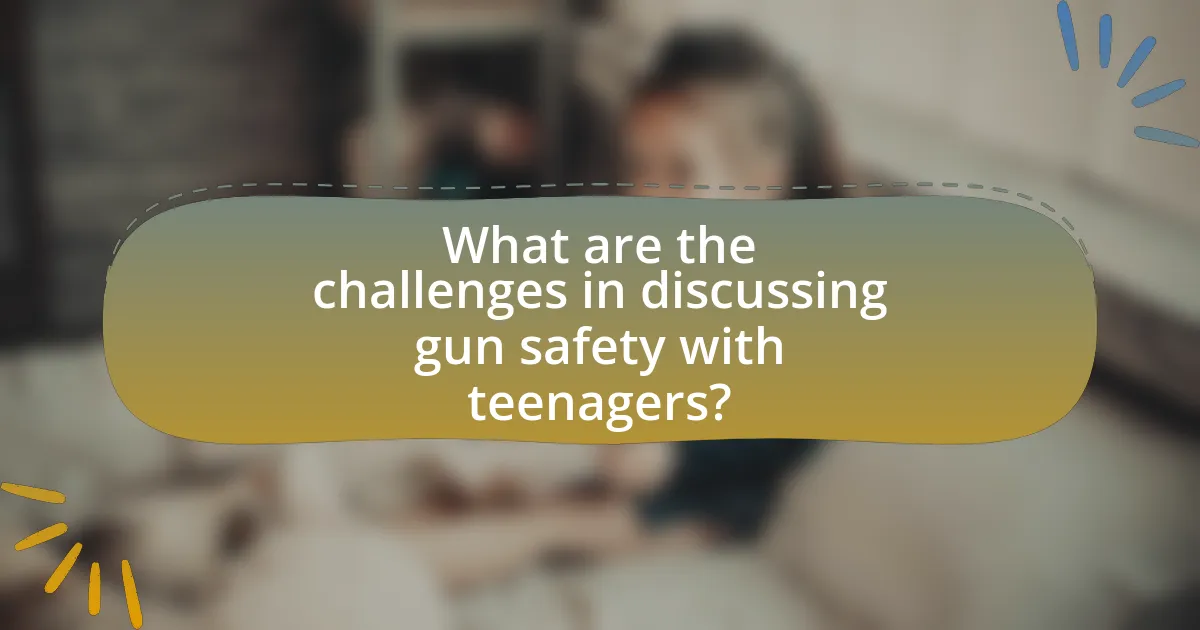
What are the challenges in discussing gun safety with teenagers?
Discussing gun safety with teenagers presents several challenges, primarily due to their developmental stage and varying levels of understanding. Teenagers often exhibit a sense of invulnerability and may underestimate risks associated with firearms, making it difficult to convey the seriousness of gun safety. Additionally, societal influences, such as peer pressure and media portrayals of guns, can lead to conflicting attitudes towards firearms, complicating open dialogue. Research indicates that adolescents are more likely to engage in risky behaviors, which can include improper handling of guns, highlighting the need for effective communication strategies tailored to their unique perspectives.
How can parents address misconceptions about guns among teenagers?
Parents can address misconceptions about guns among teenagers by engaging in open and honest conversations that provide accurate information about firearms. This approach allows parents to clarify myths, such as the belief that guns are inherently safe or that they are only used for hunting. Research indicates that discussions about gun safety can significantly reduce the likelihood of unsafe behaviors; for instance, a study published in the Journal of Adolescent Health found that adolescents who received education about gun safety were less likely to engage in risky behaviors involving firearms. By using factual data and real-life scenarios, parents can help teenagers understand the responsibilities and dangers associated with gun ownership, fostering a more informed perspective.
What strategies can help in discussing peer pressure related to gun use?
To effectively discuss peer pressure related to gun use, open communication is essential. Engaging children in conversations about their feelings and experiences with peers can help them articulate their thoughts on gun use and peer influence. Research indicates that children who feel comfortable discussing sensitive topics with their parents are more likely to resist negative peer pressure. Additionally, role-playing scenarios can empower children to practice responses to peer pressure, enhancing their confidence in real-life situations. Studies show that children who participate in such exercises are better equipped to handle peer influence regarding risky behaviors, including gun use.
How can parents foster a responsible attitude towards guns in teenagers?
Parents can foster a responsible attitude towards guns in teenagers by engaging in open, honest conversations about gun safety and responsibility. Establishing a foundation of trust allows teenagers to feel comfortable discussing their thoughts and questions regarding firearms. Parents should educate their teenagers about the potential dangers of guns, emphasizing the importance of safety measures such as proper storage and handling. Research indicates that consistent discussions about gun safety can significantly reduce the likelihood of accidents; for instance, a study published in the Journal of Adolescent Health found that adolescents who received education on gun safety were less likely to engage in risky behaviors involving firearms. By modeling responsible behavior and encouraging critical thinking about the implications of gun ownership, parents can instill a sense of accountability in their teenagers.
What resources are available for parents to aid in discussions about gun safety?
Parents can access various resources to facilitate discussions about gun safety, including educational websites, community programs, and literature specifically designed for families. The National Rifle Association (NRA) offers the “Eddie Eagle GunSafe Program,” which provides materials for teaching children about gun safety in a non-threatening manner. Additionally, organizations like Everytown for Gun Safety provide guides and toolkits for parents to engage in age-appropriate conversations about firearms. Research indicates that early and open discussions about gun safety can significantly reduce the risk of accidental shootings among children, highlighting the importance of these resources in promoting safe practices.
What educational materials can help facilitate these conversations?
Educational materials that can help facilitate conversations about gun safety with children include age-appropriate books, interactive workshops, and educational videos. For instance, books like “My Parents Open Carry” by Brian Jeffs and “The Berenstain Bears Safe and Sound” provide narratives that introduce gun safety concepts in a relatable manner for young readers. Workshops conducted by organizations such as the National Rifle Association (NRA) offer hands-on experiences and discussions tailored to different age groups, reinforcing safety principles. Additionally, educational videos from sources like the Eddie Eagle GunSafe Program present engaging content that teaches children how to respond to firearms they may encounter. These materials are effective because they combine storytelling, practical exercises, and visual learning, making the topic accessible and understandable for children.
How can community programs support parents in teaching gun safety?
Community programs can support parents in teaching gun safety by providing educational workshops and resources tailored to different age groups. These programs often include hands-on training sessions, informational materials, and expert-led discussions that equip parents with the knowledge and skills necessary to communicate effectively about gun safety with their children. For instance, the National Shooting Sports Foundation offers resources that emphasize safe storage practices and the importance of discussing firearms openly, which can significantly reduce the risk of accidental shootings among children.
What are some practical tips for discussing gun safety with children of all ages?
To effectively discuss gun safety with children of all ages, start by establishing an open and honest dialogue about firearms. Use age-appropriate language and concepts; for younger children, focus on the idea that guns are not toys and should never be touched without adult supervision. For older children, engage in discussions about the responsibilities that come with gun ownership and the importance of safety measures.
Incorporate practical scenarios, such as what to do if they encounter a gun, emphasizing the importance of telling an adult immediately. Reinforce the message by using resources like the National Rifle Association’s Eddie Eagle GunSafe Program, which teaches children to “Stop, Don’t Touch, Run Away, and Tell a Grown-Up.” This program has been effective in educating children about gun safety in a clear and memorable way.
